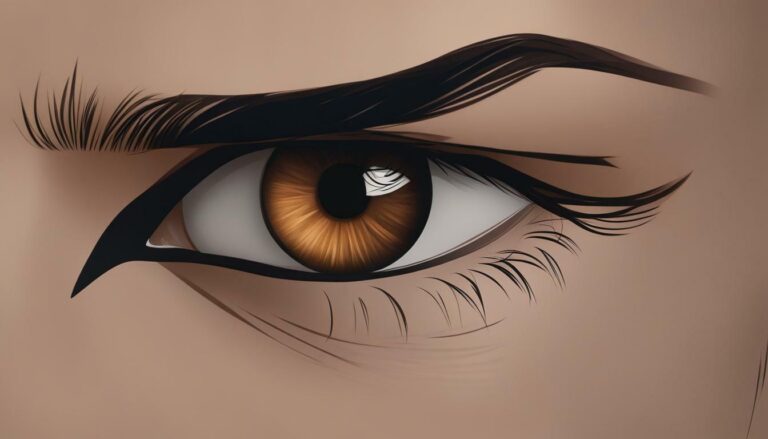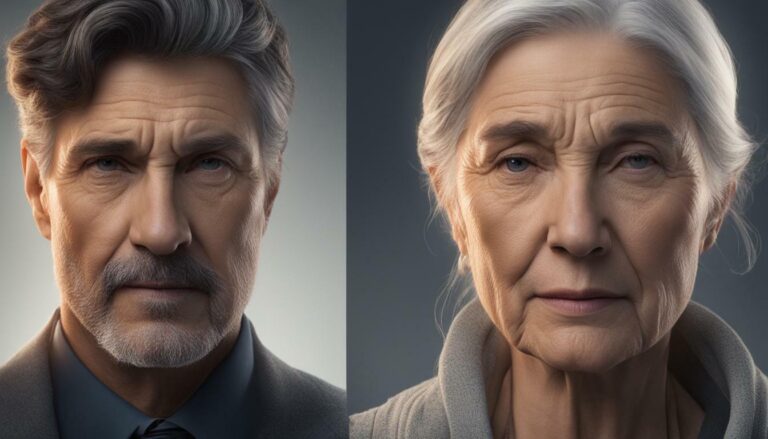What is Diet Face?
“Diet face” is a term used to describe the changes in facial appearance that occur as a result of weight loss. As we age, the fat pads in our face naturally diminish, leading to a loss of volume and a more hollow, gaunt appearance. However, rapid weight loss and certain weight loss diets can also contribute to this effect.
To prevent diet face, it’s important to focus on healthy eating habits and maintain a balanced diet. Crash dieting should be avoided as it can worsen the effects of weight loss on facial appearance. Good hydration, a diet rich in protein and vegetables, and the use of moisturizers and sunscreen can all help maintain a youthful facial appearance.
Key Takeaways:
- Diet face refers to the changes in facial appearance that occur due to weight loss.
- Facial fat pads naturally diminish as we age, leading to a loss of volume in the face.
- Rapid weight loss and crash diets can worsen the effects of diet face.
- Maintaining a healthy weight, following a balanced diet, and staying hydrated can help prevent diet face.
- Non-surgical treatments like dermal fillers and thread lift treatments can help restore facial volume.
What Causes Diet Face?
Diet face is a phenomenon that occurs due to a combination of factors, primarily the shrinkage of facial fat pads. These fat pads naturally diminish as we age, leading to a loss of volume and definition in the cheeks and lower face. However, rapid weight loss and exercise can further shrink these fat pads, resulting in more noticeable and pronounced changes in facial appearance.
The primary causes of diet face include:
- Fat pad shrinkage: The fat pads in the face provide support and structure. As they shrink, the face can appear hollowed-out and less youthful.
- Facial structure changes: The diminished fat pads can lead to sagging skin and the formation of jowls, further contributing to the aging and hollowing effect.
This image depicts the process of fat pad shrinkage in the face, which can contribute to diet face. The loss of volume and definition in the cheeks and lower face can ultimately result in a more aged and hollow appearance.
Effects of Diet Face on Facial Appearance
The effects of diet face can be quite significant and may include:
- Sagging skin: As the fat pads shrink, the skin can lose its elasticity, leading to sagging skin in the cheeks, jawline, and jowls.
- Premature aging: Diet face can accelerate the aging process, making the skin appear more prematurely aged due to the loss of facial volume.
Diet face is a common concern for individuals who have experienced significant weight loss or are aging. Understanding the causes and effects of diet face can help individuals take preventative measures and explore non-surgical treatments to address these concerns.
In the next section, we will discuss strategies to prevent diet face and maintain a youthful and vibrant facial appearance.
How to Prevent Diet Face?
To prevent diet face and maintain a healthy facial appearance, it is important to focus on several key aspects:
- Maintain a Healthy Weight: One of the best ways to prevent diet face is by maintaining a healthy weight throughout your life. This can be achieved through a combination of a balanced and nutritious diet, regular exercise, and a lifestyle that promotes overall well-being.
- Follow a Healthy Diet and Exercise Routine: Ensure that your diet is rich in protein and vegetables. These food groups provide essential nutrients that support healthy skin and facial structure. Regular exercise also helps maintain overall body fitness and minimizes rapid weight loss, preventing the loss of facial volume.
- Avoid Crash Dieting: Crash dieting can worsen the effects of weight loss on facial appearance. It often leads to rapid weight loss, which can result in the shrinkage of facial fat pads and a more noticeable impact on facial structure. Instead, prioritize gradual and sustainable weight loss methods.
- Hydrate Your Skin: Facial hydration is essential in maintaining supple skin and preventing premature aging. Use a good moisturizer daily and make sure to protect your skin from the sun’s harmful rays by applying sunscreen with a high SPF.
By incorporating these practices into your lifestyle, you can help prevent diet face and maintain a youthful and healthy facial appearance.

Treating Diet Face
If you are unhappy with the effects of weight loss on your facial structure, there are non-surgical treatment options available to help address diet face. These treatments can restore lost volume and improve the appearance of sagging skin, providing a more youthful and rejuvenated look.
Dermal Fillers
Dermal fillers are a popular non-surgical option for treating diet face. These injectable gels are made of hyaluronic acid, a natural substance found in the body that provides volume and hydration to the skin. By strategically injecting dermal fillers into areas of volume loss, such as the cheeks and jawline, a skilled medical professional can restore facial fullness and definition.
Thread Lift Treatments
Another non-surgical option for treating diet face is a thread lift. This procedure involves the insertion of dissolvable threads into the skin to lift and tighten sagging areas. The threads stimulate collagen production, resulting in firmer and more youthful-looking skin. Thread lift treatments can improve the appearance of sagging cheeks, jowls, and neck, providing a subtle, yet noticeable lift.
Other Non-Surgical Treatments
In addition to dermal fillers and thread lift treatments, there are other non-surgical options available for treating diet face. High-tech treatments, such as toning with micro-currents, can tighten and lift loose skin, improving the overall contour of the face. These non-invasive procedures offer effective alternatives to surgical interventions, with minimal downtime and natural-looking results.
“Non-surgical treatments like dermal fillers and thread lift procedures can help restore lost volume and improve the appearance of diet face, without the need for invasive surgery.”
When considering non-surgical treatments for diet face, it is important to consult with a qualified medical professional who can assess your specific needs and recommend the most suitable treatment plan. They will consider factors such as your facial anatomy, skin condition, and desired outcome to provide personalized care and achieve natural-looking results.
The Effects of Weight Loss on Facial Appearance
Dramatic weight loss can have significant effects on your facial appearance. As you shed excess pounds, you may notice changes in the volume and contours of your face, which can impact your overall look and youthfulness. Understanding these effects can help you be prepared for the potential changes that come with weight loss.
One of the most common effects of weight loss on the face is sagging skin. When you lose a significant amount of weight, the skin may not have enough time to adjust and tighten. This can result in loose and saggy skin, particularly in the cheeks, jowls, and around the jawline. Sagging skin can contribute to a more aged and tired appearance.
In addition to sagging skin, weight loss can also lead to the prominence of naso-labial lines, which are the lines that run from the sides of your nose to the corners of your mouth. These lines may become more noticeable as the volume and plumpness in your face diminishes.
The area around your eyes can also be significantly affected by weight loss. As you lose fat in your face, the eyes may appear hollow and sunken, giving a tired and older appearance.
It’s important to note that weight loss can accelerate the natural aging process of the face. As we age, our face naturally loses volume, resulting in a more gaunt and aged appearance. When weight loss is added to the equation, these aging effects can become more pronounced, making the skin appear prematurely aged.
To minimize the effects of weight loss on your facial appearance, it is recommended to opt for gradual weight loss rather than rapid and drastic methods. This allows the skin and underlying tissues to adjust and adapt to the changes in a more natural way. Additionally, maintaining a healthy and balanced diet can help support the overall health of your skin and minimize sagging.
Celebrities and Diet Face
Many celebrities have openly discussed their experiences with diet face and the profound impact of weight loss on their facial appearance. High-profile individuals such as Dame Jenni Murray, Jane Fonda, Courteney Cox, and Madonna have all spoken about the challenges of navigating the delicate balance between maintaining a youthful face and achieving a slim body.
However, it’s important to remember that each person’s experience with diet face is unique, and individual results may vary. What works for one celebrity may not necessarily be suitable for everyone. The key takeaway is to prioritize overall health and well-being while pursuing a balanced and healthy lifestyle.
Weight loss transformations can be impressive, but it’s crucial to approach them with caution and a long-term perspective. A healthy and sustainable approach to weight loss is always preferred over crash diets or extreme measures. Adequate nutrition, regular exercise, and proper hydration are vital for overall health, both inside and out.
“The pursuit of a youthful appearance should never compromise your overall well-being. Strive for a healthy and balanced lifestyle, and let your natural beauty shine through.”
– Dame Jenni Murray
Celebrities serve as inspirations for many individuals facing their own weight loss journeys. While it’s important to appreciate the transformation and dedication they display, it’s equally vital to remember that the pressures they face in the public eye may not align with everyone’s reality.
Ultimately, diet face is just one aspect of the broader discussion around weight loss and body image. By embracing realistic expectations, practicing self-care, and focusing on overall health, individuals can achieve their weight loss goals while also maintaining facial volume and a natural, balanced appearance.

Conclusion
Diet face is a real phenomenon that can occur due to weight loss and age-related changes in facial fat pads. As we age, the fat pads in our face naturally diminish, leading to a loss of volume and a more hollowed-out appearance. Rapid weight loss and exercise can exacerbate this process, making the facial changes more apparent.
However, maintaining a healthy weight throughout life can help prevent diet face. By following a balanced diet that is rich in protein and vegetables, you can support the health and integrity of your facial fat pads. Gradual weight loss, as opposed to crash dieting, can also minimize the effects of facial volume loss.
If you are unsatisfied with the effects of weight loss on your facial structure, non-surgical treatments are available. Dermal fillers can restore lost volume and provide definition, while thread lift treatments can improve sagging skin. These treatments offer a non-invasive way to rejuvenate your appearance without the need for surgery.
Remember, maintaining a healthy weight and prioritizing your overall well-being are crucial in achieving a balanced and youthful facial appearance. By adopting healthy lifestyle habits and taking advantage of non-surgical options when needed, you can preserve your natural facial volume and age gracefully.
FAQ
What is diet face?
Diet face refers to the phenomenon of changes in facial appearance that occur due to weight loss. As we age, the fat pads in our face diminish, leading to a loss of volume and a more hollow, gaunt appearance.
What causes Diet Face?
Diet face is primarily caused by the shrinkage of facial fat pads that provide support and structure to the face. These fat pads naturally diminish as we age, resulting in a loss of volume and definition in the cheeks and lower face. When weight is lost rapidly or through exercise, the fat pads can shrink even further, leading to a more noticeable and pronounced effect on facial appearance.
How to prevent Diet Face?
The best way to prevent diet face is to maintain a healthy weight throughout life. This can be achieved through a combination of a healthy diet that includes plenty of protein and vegetables, along with regular exercise. Crash dieting should be avoided as it can worsen the effects of weight loss on facial appearance. Good hydration is also essential for maintaining supple skin, and using a good moisturizer and daily sunscreen can help protect the skin and prevent premature aging.
How to treat Diet Face?
If you are unhappy with the effects of weight loss on your facial structure, there are non-surgical treatment options available. Dermal fillers can be used to restore lost volume and provide definition and support to the face. Thread lift treatments can also improve the appearance of sagging skin. These treatments can help restore a more youthful and rejuvenated appearance without the need for surgery. Other high-tech treatments like toning with micro-currents can also achieve remarkable results in tightening and lifting loose skin.
What are the effects of weight loss on facial appearance?
Dramatic weight loss can lead to noticeable changes in facial appearance. The loss of volume from the face can result in sagging skin, especially in the cheeks, jowls, and around the jawline. Nasolabial lines may become more prominent, and the eyes can appear hollow and sunken. As the natural aging process already involves a loss of volume in the face, weight loss can accelerate these changes, making the skin appear more prematurely aged. Gradual weight loss and a healthy, balanced diet can help minimize these effects.
Do celebrities experience diet face?
Many celebrities have spoken about their experiences with diet face and the impact of weight loss on their facial appearance. Dame Jenni Murray, Jane Fonda, Courteney Cox, and Madonna are among those who have discussed the phenomenon of choosing between a youthful face and a slim body. However, it’s important to remember that everyone’s experience with diet face is unique, and individual results may vary. The key is to prioritize overall health and well-being while maintaining a balanced and healthy lifestyle.
What is the conclusion about diet face?
Diet face is a real phenomenon that can occur due to weight loss and age-related changes in facial fat pads. While everyone experiences some degree of facial volume loss as they age, rapid weight loss and exercise can accelerate this process, leading to a more noticeable difference in facial appearance. However, maintaining a healthy weight throughout life and following a balanced diet rich in protein and vegetables can help prevent diet face. Non-surgical treatments such as dermal fillers and thread lift treatments are available for those who are unhappy with the effects of weight loss on their facial structure. Remember, prioritizing overall health and well-being is key in achieving a balanced and youthful appearance.






